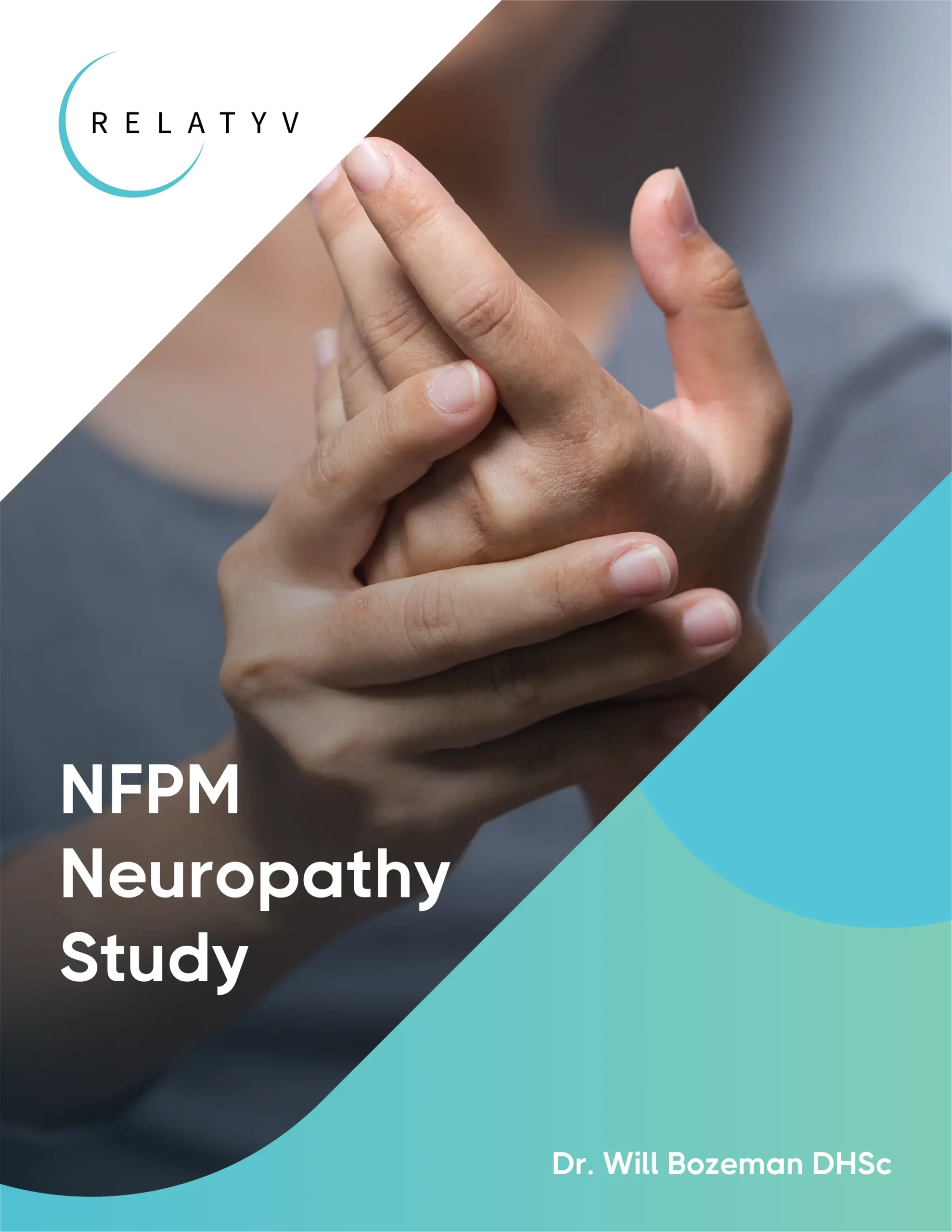Muscle Spasms

Beyond The Contractions: Muscle Spasm Vs. Twitch
Read More
November 21, 2023
The pelvic floor is a group of muscles surrounding your pelvis, connecting the pubic bone in front to the tailbone at the back. It helps support your organs and control bladder and bowel movements. When these muscles become too tight, they can cause several issues that can significantly impact your overall quality of life.
At Relatyv, we can treat the underlying neurological factors that are causing the chronic pain and inflammation associated with tight pelvic floor muscles.
The pelvic floor is made of several layers of muscles, connective tissue, and ligaments. The primary muscles of the pelvic floor include:
When the pelvic floor muscles become tight, they can cause many problems, including chronic pain. This type of pain can radiate from the lower back, down through the legs, and even into the buttocks and groin area. It’s usually described as an intense burning or aching sensation that worsens with movement.
When your pelvic floor muscles tighten, they can squeeze or compress your nerves, which results in pain. Additionally, a tight pelvic floor can put pressure on your organs and cause them to be displaced, leading to additional discomfort. This is why treating any issues you may have with your pelvic floor is vital to prevent chronic pain from developing.
Unfortunately, tight pelvic floor muscles can cause a wide variety of symptoms. If you experience one or more of the following symptoms, it may be a sign that you have tight pelvic floor muscles.
Tailbone pain is a common symptom of tight pelvic floor muscles. When the pelvic floor muscles tighten too much, they can pull on the coccyx (tailbone), causing it to press against other structures in the area. This pressure can cause a sharp pain to radiate from your lower back through your legs and even into your buttocks and groin area. This type of pain can worsen with movement or sitting for long periods of time.
Involuntary muscle spasms can be caused by tight pelvic floor muscles. How? When the muscles become too tight, they can cause the nerves in the area to be compressed. This can lead to muscle spasms that you have no control over, making it difficult to perform daily activities such as walking or sitting for long periods.
These spasms can also cause pain in the lower abdomen and groin area, as well as a feeling of heaviness or pressure. Additionally, they may be accompanied by a sense of urgency to urinate or defecate.
Tight pelvic floor muscles can also cause hip and pelvic discomfort. When the muscles become too tight, they can shift your pelvic bones out of alignment and put pressure on nearby structures such as your hips. This can result in pain in the hips and lower back, as well as a feeling of instability or weakness when you move or stand for long periods of time.
It’s also important to note that women may experience increased pain in the pelvic region during menstruation. This is due to the hormones released during this time, which can cause further tension and tightness of the pelvic floor muscles.
You may feel pain during intercourse when the muscles are too tight, as they can lead to tension of the nerves and other structures in the area. This can cause discomfort or pain during sexual penetration and a feeling of tightness or tension that prevents you from enjoying the experience.
Tight pelvic floor muscles can also cause abdominal bloating and tenderness. When the muscles become too tight, they can put pressure on your organs, including your stomach, making it feel full even when you haven’t eaten much or are relaxed. Additionally, you may have tenderness in the abdomen due to nerve compression.
Tight pelvic floor muscles can also lead to constipation. When the muscles become too tight, they can put pressure on your rectum, making it difficult to eliminate waste. This can result in constipation, which can be extremely painful and uncomfortable. This can be accompanied by abdominal bloating and tenderness.
Tight pelvic floor muscles can cause urinary symptoms such as frequent urination, urinary incontinence, and difficulty starting or stopping urine flow. These symptoms may be due to the compression of your nerves in the pelvic area, which can result in weakened bladder control. In addition to these symptoms, you may also experience a feeling of urgency to empty your bladder. This is caused by the tight muscles squeezing your nerves, making bladder control difficult.
Pain in the perineal area is another symptom of tight pelvic floor muscles. The perineal area is the area between your rectum and vagina/scrotum. When the pelvic floor muscles tighten too much, they can put pressure on your perineal nerves, resulting in pain that radiates from the lower back through the buttocks and down into the legs. This type of pain is often described as an intense burning sensation. You may also experience a feeling of heaviness or numbness in the perineal area due to nerve compression.
Tight pelvic floor muscles can also cause increased stress and anxiety. This is due to the constant tension in the area, which can lead to feelings of unease or discomfort. Additionally, tight pelvic floor muscles can make it difficult to relax and may interfere with your ability to perform daily activities.
You may also experience a feeling of pelvic pressure or heaviness when the pelvic floor muscles become too tight. This is due to the increased tension in the area, which can cause nerves to be compressed and put pressure on your organs. Additionally, you may feel like your pelvic area is heavy or that you’re carrying something in it.
There are many different things that can lead to minor tightness in the pelvic floor muscles. These things can lead to many of the symptoms you may be experiencing. Fortunately, these issues are either temporary or can be easily corrected. These include:
In addition to some of the temporary issues that can lead to minor tightness, some underlying conditions can also cause tight pelvic muscles. These conditions are more serious and require more comprehensive medical treatment to treat the symptoms you’re experiencing. These medical conditions include:
For minor tightness, a few conventional at-home treatment solutions can relieve mild to moderate symptoms. These treatments include the following:
At Relatyv, we use a Neurofunctional Pain Management approach to treating chronic pain associated with tight pelvic floor muscles. We do this by identifying the root cause and using a multi-faceted approach to address the pain instead of simply masking the symptoms. Our whole-person treatment plan includes drug-free, non-invasive, non-surgical, and non-chiropractic therapies to help manage your pain and inflammation. The treatment modalities include the following:
Electroanalgesia is a therapy that uses electrical stimulation (e-stim) to target pain receptors and disrupt the transmission of pain signals to the brain. This can be especially useful for tight pelvic floor muscles since the electrical impulses can help to relax the muscles.
The use of electroanalgesia also helps to increase blood flow to reduce inflammation. Unlike other types of e-stim therapies, electroanalgesia can penetrate deeper into the tissues, providing more effective and longer-lasting pain relief. This is because electroanalgesia delivers significantly more pulses per second than other e-stim treatments. Whereas something like TENS can only deliver up to 400 pulses per second, electroanalgesia can reach 10,000 pulses per second.
Intravenous (IV) therapy is a form of treatment that delivers nutrients, vitamins, and minerals directly into the bloodstream. This allows for fast absorption of these essential elements by bypassing the digestive system. IV therapy helps restore balance in the body, reduce inflammation, and improve overall well-being. When it comes to chronic pain that’s caused by pelvic floor muscle tightness, nutrients such as magnesium, calcium, and vitamin B12 can help to relax the muscles, reduce pain, and promote healing.
At Relatyv, we offer lifestyle counseling as part of our whole-person approach to help our patients make necessary changes that can contribute to their healing process. Our team will work with you to identify any potential triggers for your tight pelvic floor muscles and provide guidance on how to avoid them. We also provide stress management techniques, as chronic stress and anxiety can contribute to the tension in your pelvic floor muscles. Making lifestyle changes can significantly improve your overall well-being and help manage pain caused by tight pelvic floor muscles.
If you are experiencing any of the symptoms associated with tight pelvic floor muscles, it is crucial to seek immediate medical advice from a professional. Doing so can help identify any underlying conditions that may be causing your discomfort and ensure that you receive the appropriate treatment plan for your individual needs.
At Relatyv, we can help provide long-term relief from the pain and inflammation that are associated with tight pelvic floor muscles by addressing the neurological factors that may be contributing to the underlying conditions. Contact us today to learn more about our Relatyv protocol and how we can help you find relief from the discomfort.
About the Author
Will is a healthcare executive, innovator, entrepreneur, inventor, and writer with a wide range of experience in the medical field. Will has multiple degrees in a wide range of subjects that give depth to his capability as an entrepreneur and capacity to operate as an innovative healthcare executive.
Share on Social Media




You can see how this popup was set up in our step-by-step guide: https://wppopupmaker.com/guides/auto-opening-announcement-popups/
You can see how this popup was set up in our step-by-step guide: https://wppopupmaker.com/guides/auto-opening-announcement-popups/
Neurofunctional Pain Management Overview
IV Therapy
Symptoms
Conditions Treated
Treatments
Articles by Category
Locations
Colorado
Wisconsin
Georgia
Hiram
Lawrenceville
Marietta
Powder Springs
Texas
Waco
Victoria
Illinois
Buffalo Grove
New Lenox
St. Charles
Arizona
Tucson
Waddell
Arlington
Avondale
Buckeye
Superior
Mesa
Palo Verde
Morristown
Tempe
Chandler
Anthem
Eloy
Florence
Fort McDowell
Phoenix
El Mirage
Coolidge
Gilbert
Arizona City
Casa Grande
Casa Blanca
Aguila
Sacaton
Apache Junction
Kearny
Stanfield
Goodyear
Litchfield Park
Alabama
Arkansas
California
Florida
Idaho
Louisiana
Michigan
Rhode Island
Minnesota
Nevada
New Jersey
New Mexico
North Carolina
Ohio
Pennsylvania
South Dakota
Tennessee
Virginia
Washington

